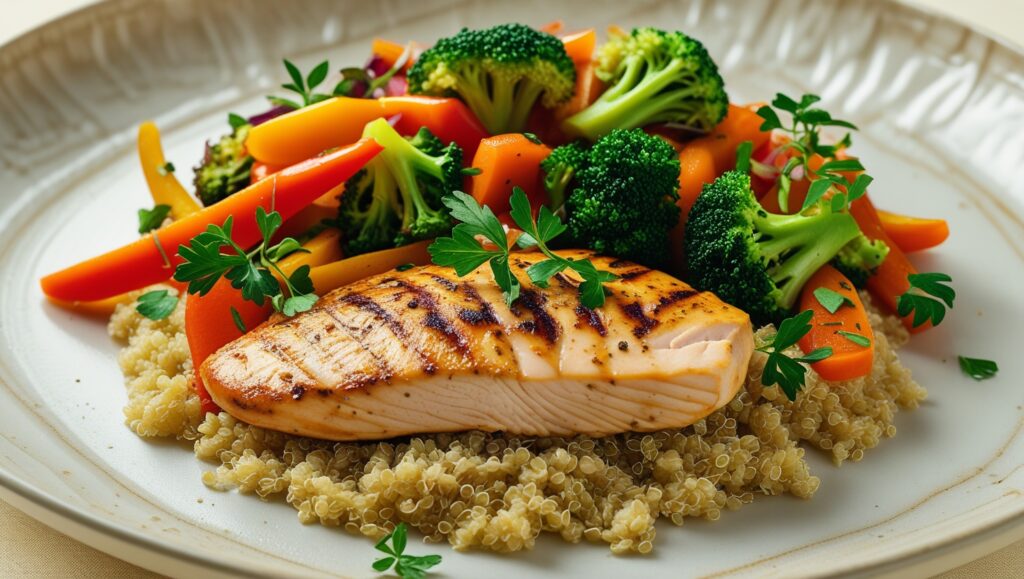What is Balanced Eating? Balanced eating involves consuming the right proportions of essential nutrients—carbohydrates, proteins, fats, vitamins, and minerals—to fuel your body effectively. It’s about variety, moderation, and making healthier choices to meet your energy needs without overindulging or depriving yourself. so, yoy must know about The Ultimate Guide to Balanced Eating for you

Key Components of Balanced Eating:
- Carbohydrates: The primary energy source. Opt for whole grains, fruits, and vegetables.
- Proteins: Essential for growth and repair. Include lean meats, beans, nuts, and dairy.
- Fats: Necessary for brain function and energy. Prioritize healthy fats like avocados, olive oil, and nuts.
- Vitamins and Minerals: Crucial for immunity and overall health. Get these from a rainbow of fruits and vegetables.
- Water: Hydration is as important as food. Aim for at least 8 glasses daily.
Benefits of Balanced Eating
- Boosts Energy Levels: A balanced diet ensures a steady supply of energy throughout the day.
- Enhances Mental Health: Proper nutrition can improve mood and cognitive function.
- Supports Weight Management: Balanced eating helps maintain a healthy weight without strict dieting.
- Reduces Disease Risk: It lowers the chances of chronic illnesses like diabetes, heart disease, and obesity.
- Improves Digestive Health: A diet rich in fiber aids digestion and prevents gastrointestinal issues.
Practical Tips for Balanced Eating
- Start with Meal Planning: Plan meals and snacks to avoid impulsive eating.
- Use the Plate Method: Fill half your plate with vegetables, one-quarter with protein, and one-quarter with whole grains.
- Portion Control: Be mindful of serving sizes to prevent overeating.
- Limit Processed Foods: Choose fresh, whole foods whenever possible.
- Listen to Your Body: Eat when you’re hungry and stop when you’re satisfied.
Balanced Eating for Different Lifestyles
For Busy Professionals:
- Pack healthy snacks like nuts, fruits, and yogurt.
- Prepare meals in advance to save time during busy workweeks.
For Families:
- Involve everyone in meal planning and preparation.
- Opt for family-friendly recipes that are both nutritious and delicious.
For Students:
- Keep quick and easy options like whole-grain wraps and protein bars.
- Stay hydrated and avoid excessive caffeine.
Common Myths About Balanced Eating
- Myth: Healthy eating is expensive. Fact: Buying seasonal produce and cooking at home can save money.
- Myth: Carbs are bad for you. Fact: Carbohydrates are essential but should come from whole grains and natural sources.
- Myth: Fats should be avoided. Fact: Healthy fats are crucial for brain function and overall health.
FAQs About Balanced Eating
Q: How can I start eating a balanced diet? A: Begin by incorporating more fruits, vegetables, and whole foods while reducing processed items.
Q: Is it okay to have cheat days? A: Yes, occasional indulgences are fine if you maintain overall balance.
Q: Can I follow a balanced diet on a tight budget? A: Absolutely. Focus on affordable staples like rice, beans, eggs, and seasonal produce.
Conclusion Balanced eating is a sustainable approach to achieving optimal health. By making small, consistent changes, you can enjoy the benefits of better energy, improved mental clarity, and overall well-being. Remember, it’s not about perfection but progress.





